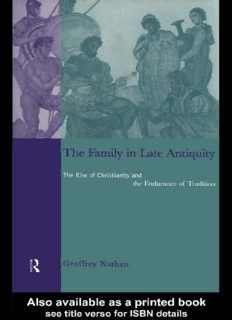
The Family in Late Antiquity: The Rise of Christianity and the Endurance of Tradition PDF
Preview The Family in Late Antiquity: The Rise of Christianity and the Endurance of Tradition
THE FAMILY IN LATE ANTIQUITY THE FAMILY IN LATE ANTIQUITY The rise of Christianity and the endurance of tradition Geoffrey S. Nathan London and New York First published 2000 by Routledge 11 New Fetter Lane, London EC4P 4EE Simultaneously published in the USA and Canada by Routledge 29 West 35th Street, New York, NY 10001 Routledge is an imprint of the Taylor & Francis Group This edition published in the Taylor & Francis e-Library, 2002. © 2000 Geoffrey Nathan The right of Geoffrey Nathan to be identified as the Author of this Work has been asserted by him in accordance with the Copyright, Designs and Patents Act 1988 All rights reserved. No part of this book may be reprinted or reproduced or utilised in any form or by any electronic, mechanical, or other means, now known or hereafter invented, including photocopying and recording, or in any information storage or retrieval system, without permission in writing from the publishers. British Library Cataloguing in Publication Data A catalogue record for this book is available from the British Library Library of Congress Cataloging in Publication Data has been applied for ISBN 0–415–16665–9 (Print Edition) ISBN 0-203-00669-0 Master e-book ISBN ISBN 0-203-20609-6 (Glassbook Format) To Nobuko, Emily and Lucas, my own family CONTENTS Acknowledgements ix Abbreviations x 1 Introduction 1 2 Two traditions 15 3 Constantine and The Confluence of Two Traditions 55 4 Marriage 74 5 Alternatives to marriage 107 6 Children 133 7 The extended family 160 8 Household slaves 169 9 Final thoughts 185 Appendix 190 Notes 192 Bibliography 246 Index 262 vii ACKNOWLEDGMENTS There are a number of people I should like to thank for their help in the production of this book. Ronald Mellor first suggested the topic to me when I was still a graduate student, and Claudia Rapp helped to make that topic a reality when I worked on my dissertation. It is from my doctoral work that this book was largely taken. Over the years, many people have given me valuable advice and input about various aspects of this work. Michele Salzman and Brent Shaw offered useful advice early on. Two experts were also particularly helpful on the matter of law: Judith Evans Grubbs and Antti Arjava pointed me in useful directions. Scott Bartchy has also been helpful, offering essential information on early Christianity, particularly in the area of slavery. Several institutions also deserve thanks. UCLA’s history department has helped to defray the costs of travel when presenting parts of my book at conferences. The Center for Medieval and Renaissance Studies, the Association for Ancient Historians, and the Byzantine Studies Conference have also permitted me to present some of my findings. Finally, I wish to thank an important layperson: my wife, Nobuko. Over the years, she has given me consistent and unqualified support, both emotional and financial. Without her, I would not have had the strength to finish my work. To her, I owe a heavy debt of gratitude. GSN Los Angeles February 1999 ix
Description: